



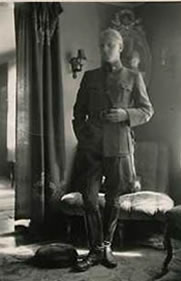 In our story of ’The Runaway Train’ Gunnar F. Klingenberg relates his experiences starting with his posting to the Anti-Aircraft battery at Rjukan.
In our story of ’The Runaway Train’ Gunnar F. Klingenberg relates his experiences starting with his posting to the Anti-Aircraft battery at Rjukan.
One of the officers in charge of the garrison at Rjukan was 2nd Lt. Karsten Lund Stenmark. After service in Northern Norway he had been sent to Vemork, a mountain plateau near Rjukan, early in 1940 as an instructor to train potential officers. Lt. Stenmark was an avid photographer. He photographed the daily routine of life in camp, the starkness of surrounding landscapes and the trials of men on the move. Long after the war he related his experiences and showed the photographs to his grandson, Johan. The almost two hundred photographs are neatly displayed in a red album that Johan now treasures. Another heirloom is a copy of a report that Lt. Stenmark wrote about the move from Rjukan, and which is used as a source for much of this article. With permission, some of the photographs are also used.
The military garrison at Vemork, under the command of Captain Finn W. Nagell, was originally part of the frontier guard of Vestfjord valley. Vemork was, and still is, the site of Norsk Hydro – one of Norway’s leading industrial companies and one of the world’s few producers of ‘heavy water’. Much of the population of Rjukan was employed by Norsk Hydro and several of the officers and men of the garrison had been recruited locally. Norsk Hydro had also contributed to the defences by purchasing, among other material, four Bofors 40 mm cannon. Part of Captain Nagell’s task was to promote harmony and understanding between the military and the civilian population. In Rjukan and at local meetings in the sparsely populated countryside Capt. Nagell spoke of the German ‘Blitzkrieg’ and warned that in spite of the increasing use of tanks and heavy armaments, the days of the hand-gun and rifle were not yet over.
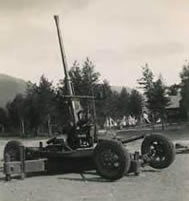 Capt Nagell’s efforts, no doubt helped by the films and press photographs of the Blitzkrieg, were rewarded by massive support from all sections of the population. In January, 170 local youngsters had enrolled for a comprehensive small-arms shooting course. The County Council bought improved fire-fighting equipment and organised air-raid shelters.
Capt Nagell’s efforts, no doubt helped by the films and press photographs of the Blitzkrieg, were rewarded by massive support from all sections of the population. In January, 170 local youngsters had enrolled for a comprehensive small-arms shooting course. The County Council bought improved fire-fighting equipment and organised air-raid shelters.
Women knitted socks and mittens and a special lottery was established. The soldiers were so impressed by the support from the local people that they inserted a rhyming, ‘Thank-you’ advertisement in both local newspapers: Thank you dear ladies for your work, strife and pride.// We don’t mind our struggles when you’re on our side.
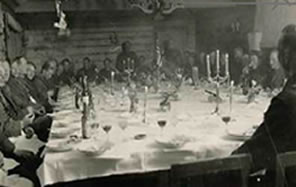 On the evening of April 8, Capt Nagell invited the men who had successfully completed a recent NCO training course to a banquet at a nearby mountain guest-house. At 23.10, the Anti-Aircraft Command at Rjukan received an order from Oslo: “Air Attack – Complete Blackout.” According to a local source, it took no more than 20 minutes to complete the blackout. Two hours later came the message that foreign warships were on their way up the Oslofjord. And then, as Lt. Lund Stenmark told his grandson many years later: “In the wee-hours of the morning Capt. Nagell’s telephone rang. He lifted the receiver, listened briefly, and gasped ‘It cannot be possible.’ He replaced the receiver, turned, and said, ‘Men, we are at war!’”
On the evening of April 8, Capt Nagell invited the men who had successfully completed a recent NCO training course to a banquet at a nearby mountain guest-house. At 23.10, the Anti-Aircraft Command at Rjukan received an order from Oslo: “Air Attack – Complete Blackout.” According to a local source, it took no more than 20 minutes to complete the blackout. Two hours later came the message that foreign warships were on their way up the Oslofjord. And then, as Lt. Lund Stenmark told his grandson many years later: “In the wee-hours of the morning Capt. Nagell’s telephone rang. He lifted the receiver, listened briefly, and gasped ‘It cannot be possible.’ He replaced the receiver, turned, and said, ‘Men, we are at war!’”
Next evening, after Quisling had declared himself Head of State on the radio and ordered a halt to resistance, Captain Nagell disconnected the national radio network from the transmitter at Rjukan, cutting off the propaganda-filled news broadcasts. On April 13th the Germans entered the fortified garrison town of Kongsberg. The commander Col. Steen 1, had surrendered without a struggle. This left the road to Rjukan undefended but the expected attack on the isolated position didn’t materialise immediately. Perhaps this was because the enemy knew of the anti-aircraft artillery – or because Norsk Hydro was partially owned by German interests – and was of vital scientific importance to their war efforts?
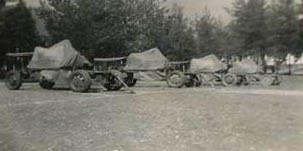 On Saturday April 20 came the order to move the Rjukan battery to join the IV Division in Numedal. Because of technical difficulties it was not possible to start on Saturday but by Sunday evening three of the four cannon were serviceable and at 21:00 the movement order was given for departure at 22:30.
On Saturday April 20 came the order to move the Rjukan battery to join the IV Division in Numedal. Because of technical difficulties it was not possible to start on Saturday but by Sunday evening three of the four cannon were serviceable and at 21:00 the movement order was given for departure at 22:30.
The troop comprised:
2nd Lt. Stenmark Officer in charge
2nd Lt. Calmeyer Second in command
Sergeants: Opsal, Stabbetorp, Wessel, Klingenberg 2, Rasmussen,
Blomhoff, Bjerkholdt, Firing, Larsen
Radio Operator: Ingvoldstad.
Other ranks: 48.
Vehicles: 11.
Petrol: 3000 litres.
Route: Hovinheia – Kongsberg – Numedal.
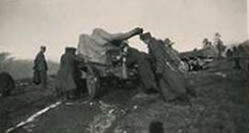 The going was tough because of the spring thaw, but with a few minor difficulties, the manoeuvre was completed without incident. In Numedal, however, because of destroyed bridges, the convoy had to use rough logging roads through rugged terrain. (For more personal experiences of this, and the continuing journey, see:Gunnar F. Klingenberg, The Runaway Train.)
The going was tough because of the spring thaw, but with a few minor difficulties, the manoeuvre was completed without incident. In Numedal, however, because of destroyed bridges, the convoy had to use rough logging roads through rugged terrain. (For more personal experiences of this, and the continuing journey, see:Gunnar F. Klingenberg, The Runaway Train.)
At Rødberg the troop met up with the Dageli group, IV Division, under the leadership of Capt. Bruun. Two of the cannon were placed overlooking a power-station and the valley, the third was placed lower down on the opposite side. Both batteries were given the same order they had received at Rjukan:“Shooting shall not commence unless attacked by an aircraft or unless it changes course and appears to be about to attack.”
At a meeting with Capt. Bruun, Stenmark and Calmeyer asked him if this order still applied: “Damn right you fire if you see a German ‘plane and you are sure you can hit it,” came the reply.
During the following two days the enemy activity in the air over Numedal was lively and direct hits were made on Veggli railway station. The three Bofors cannon fired a total of 130 rounds and the report characterises the shooting as “very good.” Two hits were reported – but not confirmed.
The remainder of Lt. Stenmark’s report details the orders and counter-orders, the minor skirmishes, the marches and transports of men who were eager to fight the enemy but who had no clear knowledge of where the enemy was to be found. As the following shortened extract indicates – it must have been frustrating:
22:00 Tuesday – left Rødberg – mountain road – many difficulties.
08:00 Wednesday – arrived Geilo. 11:00 German bomber attack – two planes shot down.
16:00 Wednesday – new orders – follow infantry back to Gol – arrived kl.21:00.
05:00 Thursday – Air-raid warning. Urgent meeting with Bruun – Leira occupied by enemy.
17:00 Thursday – orders to fight your way through Gol to Ål – board train to Myrdal.
At Myrdal he notes that: The Gravdals tunnel…was blocked…a mountain locomotive had been sent through. 3
On May 1st at 1100, news of the Allied withdrawal from Southern Norway arrived – the end of the beginning! As Lt. Stenmark reports: “Our forces had the choice of returning home or heading north, most of the men left the same evening via Vadheim to Bergen.”
Some of them were taken prisoner but many of them, no doubt, joined the Resistance movement and continued to fight for a free Norway.
Postscript.
Lt. Stenmark returned to Oslo where he was demobbed and decided to continue his engineering studies. Chance took him to Germany where, like several other Norwegian students, he sent useful information to Norway about the situation and conditions under the Nazis. He lived in Dresden until just prior to the Allied destruction of that city. On his return to Oslo in 1945 he was immediately called up and joined the Army again.
Almost 45 years later he and his wife decided to visit Germany. In Dresden, the city where most of the homes had been either completely destroyed or made uninhabitable on those terrible February nights in 1945, the house where he had lodged remained as he remembered. He knocked on the door. A woman opened, looked at the couple standing there, stepped forward, and said: “lieber Stenmark!”
1 After the war, the War Inquiry Commission acquitted Col Steen of the charge of dereliction of duty.
2 See: Gunnar F. Klingenberg The Runaway Train.
3 See: Gunnar F. Klingenberg The Runaway Train